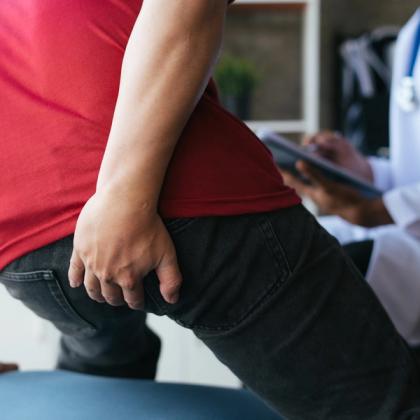Anal fissures are small tears or cracks in the lining of the anus which can cause pain, bleeding and discomfort, particularly during bowel movements. They are quite common and can be caused by various factors such as constipation, diarrhoea, childbirth or anal trauma. Treatment often involves keeping the stool soft and avoiding straining during bowel movements. This may include dietary changes, fibre supplements, topical medications, or in some cases, surgery. In this episode – which has been suggested as a topic by one of our listeners – Dr Roger Henderson looks at these in more detail as well as when to refer, and the options available for treatment in secondary care.
Key references
- NICE. Treatment Summaries. Anal fissure. Accessed 27 February 2024.
- NHS. Anal Fissure. 9 November 2021.
- Jahnny B and Ashurst JV. 2022. In: StatPearls [Internet]. Treasure Island (FL): StatPearls Publishing.
- Nelson RL. BMJ. 2003;327(7411):354-5. doi: 10.1136/bmj.327.7411.354.
- Nelson RL, et al. Cochrane Database Syst Rev. 2012;2012(2):CD003431. doi: 10.1002/14651858.CD003431.pub3.
Key take-home points
- Anal fissures are common, with a lifetime incidence of at least 10%.
- They occur most commonly between the ages of 20 and 45, with men and women being equally affected.
- Acute fissures are present for 6 weeks or less, chronic fissures for more than 6 weeks.
- They can also be classified as primary (no obvious cause) or secondary due to another underlying condition.
- Primary fissures tend to be relatively simple and benign. Secondary fissures are usually multiple.
- The diagnosis is made on the history and examination. Do not attempt a digital rectal examination at time of presentation because this can be excruciatingly painful.
- Further investigations are only warranted if there are other features of pathology that need assessing.
- Primary anal fissures can usually be managed conservatively with treatments such as increased dietary fibre, warm baths, topical ointments such as glyceryl trinitrate (GTN) or local anaesthetic and occasionally, botulinum toxin injections. Surgery may be required if these options fail.
- Refer children early, and adults if pain has not resolved within 6–8 weeks. Refer adults if their fissure is still present after 16 weeks even if asymptomatic
- Medical secondary care options include topical diltiazem, oral nifedipine and botulinum toxin.
- Surgical options include lateral internal sphincterotomy (the procedure of choice), fissurectomy, and anterior levatorplasty. Manual anal stretches should no longer be used for chronic anal fissures.
- Fortunately, most acute anal fissures heal quickly with conservative treatments, but recurrence is common.
- The prognosis in secondary fissures depends on the underlying pathology.
- With surgical intervention, the prognosis following lateral internal sphincterotomy is excellent although the risk of longer-term incontinence can be significant.
Create an account to add page annotations
Add information to this page that would be handy to have on hand during a consultation, such as a web address or phone number. This information will always be displayed when you visit this page
